Sri Lanka - Institut de statistique de l'Unesco
Sri Lanka - Institut de statistique de l'Unesco
Sri Lanka - Institut de statistique de l'Unesco
You also want an ePaper? Increase the reach of your titles
YUMPU automatically turns print PDFs into web optimized ePapers that Google loves.
Out-of-School Children in <strong>Sri</strong> <strong>Lanka</strong>: Country Study<br />
CHAPTER 1:<br />
INTRODUCTION<br />
At the beginning of 2010, UNICEF and the UNESCO <strong>Institut</strong>e for Statistics (UIS) launched the<br />
Global Initiative on Out-of-School Children. The goal of the initiative is to introduce a more<br />
systematic approach to addressing the problem of out-of-school children (OOSC), and to gui<strong>de</strong><br />
concrete sectoral reforms in this regard. Analysis of the situation shows that there are key data,<br />
analysis and policy gaps un<strong>de</strong>rlying the problem. As part of this initiative, <strong>Sri</strong> <strong>Lanka</strong> has been<br />
selected to conduct a country study with the objective of examining currently available<br />
statistical information on OOSC, scrutinizing factors related to exclusion from schooling, and<br />
i<strong>de</strong>ntifying existing policies that are effective at enhancing participation as well as gaps in<br />
policy and social protection provisions. The country studies will feed into regional overviews, a<br />
global study, and a global conference to leverage resources for equity in education. In early<br />
2011, UNICEF <strong>Sri</strong> <strong>Lanka</strong> commissioned the Centre for Women’s Research (CENWOR) to<br />
conduct the analysis for the <strong>Sri</strong> <strong>Lanka</strong>n country study and prepare this report.<br />
The report is divi<strong>de</strong>d into five chapters. Chapter 1 is an introduction, giving the country context,<br />
an overview of the current education system, and the methodology for the study. Chapter 2<br />
examines macro-level data from national surveys to create profiles of children likely to be<br />
exclu<strong>de</strong>d, using a methodology provi<strong>de</strong>d by UIS as part of the global initiative. Chapter 3<br />
analyses secondary data on barriers and bottlenecks that affect school participation in <strong>Sri</strong><br />
<strong>Lanka</strong> and relates these to the profiles of exclu<strong>de</strong>d or at-risk children. Chapter 4 examines<br />
education and social protection policies and programmes that address barriers and bottlenecks<br />
and i<strong>de</strong>ntifies gaps in policy and provision. Chapter 5 presents conclusions and<br />
recommendations.<br />
1.1 Country context<br />
<strong>Sri</strong> <strong>Lanka</strong> is an island nation located in the tropics just south of India. It has a population of 20<br />
million, of whom 28.9 percent are children aged less than 18 years and 17.8 percent are<br />
children aged 5–14 years (the compulsory-education age group for <strong>Sri</strong> <strong>Lanka</strong>) (UNICEF, 2011;<br />
DCS, 2011a). It has a score of 0.691 on the Human Development In<strong>de</strong>x, ranking it at 97th of<br />
187 countries (UNDP, 2011). It is categorized as a medium human <strong>de</strong>velopment country, with<br />
a per capita GDP of US$ 4,772 in 2009. The urban population accounts for 14.3 percent of the<br />
total population. The ethnic composition is Sinhalese (82.0 percent), <strong>Sri</strong> <strong>Lanka</strong>n Tamil (4.3<br />
percent), Indian Tamil (5.1 percent), <strong>Sri</strong> <strong>Lanka</strong>n Moors (7.9 percent), Malays (0.3 percent),<br />
Burghers (0.2 percent) and others (0.2 percent) (DCS, 2008a). A selection of socioeconomic<br />
indicators is given in Table 1.1.<br />
1

















